HAIL TO THE KING! JUPITER IS AT ITS BEST THIS MONTH
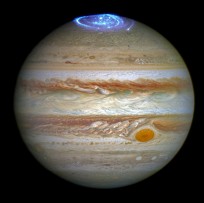
Named for the king of the Roman gods, the planet Jupiter returns to our evening sky this month and reaches opposition on April 7th. When astronomers say that a planet is at “opposition” what they mean it that it has reached a point in its orbit where it is positioned directly opposite the Sun from our perspective, with the Sun, Earth, and planet all aligned. When a planet is at opposition it is also at its closest distance to us for the year. What does this mean for you the observer? Well, it means that the planet rises at sunset, stays up all night, is at it its biggest when seen through binoculars or a telescope, and is also at its brightest. In other words, it is at its best for viewing.
WHEN AND WHERE TO LOOK
After dark this month, look for Jupiter in the east, you can’t miss it as it is the brightest thing in this part of the sky outside of the moon. During the first half of April it won’t clear the horizon very much until around 9PM, by mid-month it rises earlier and you can start looking for it by around 8PM, by the end of April it will have risen earlier still and should be well positioned in the sky by 7PM. All this year the planet Jupiter hangs out near the star Spica, the brightest star in the constellation of Virgo. So, here’s another way to locate the planet Jupiter. Every Boy Scout and amateur astronomer worth his/her salt knows this useful mnemonic: Arc to Arcturus and then speed on to Spica.
Locate the Big Dipper. Now, find the Dipper’s handle. Extend the arc of the handle out a ways until you come to the bright orange star Arcturus, the brightest star in the constellation of Bootes (pronounced Bow-oh-tees). Now, extend your curved line out again until you come to the lovely blue-white star Spica, brightest star in the constellation of Virgo. After arcing to Arcturus and speeding on to Spica you can now just jog on to Jupiter. The giant planet lies just above the star Spica.
WHAT YOU ARE SEEING
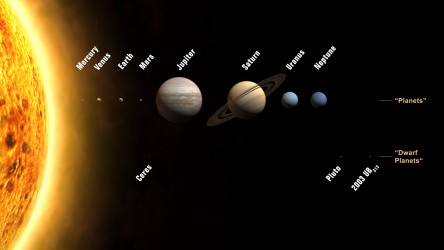 We know that the solar system formed some 4.6 billion years ago when a giant nebula of hydrogen gas and dust collapsed into a spinning disc. During the first hundred million years or so after the birth of our Sun, the planets began to form out of the remainders of this protoplanetary disc of gas and dust. Rocky planets like Mercury, Venus, Earth, and Mars formed close in to the Sun while gas giants such as Jupiter, Saturn, Uranus, and Neptune all formed further out. Like the Sun, Jupiter is made up of mostly hydrogen (89%) and helium (11%) with a smattering of other elements. Sometimes you will hear it said that Jupiter is a star that has failed to ignite with nuclear fusion. This simply isn’t true. Jupiter would need at least 80 times more mass before it could undergo fusion within its core and there simply isn’t that much mass in our solar system. This behemoth planet has a diameter of 88,846 miles, scoop out its innards and you could easily fit all the other planets inside it with plenty of room to spare.
We know that the solar system formed some 4.6 billion years ago when a giant nebula of hydrogen gas and dust collapsed into a spinning disc. During the first hundred million years or so after the birth of our Sun, the planets began to form out of the remainders of this protoplanetary disc of gas and dust. Rocky planets like Mercury, Venus, Earth, and Mars formed close in to the Sun while gas giants such as Jupiter, Saturn, Uranus, and Neptune all formed further out. Like the Sun, Jupiter is made up of mostly hydrogen (89%) and helium (11%) with a smattering of other elements. Sometimes you will hear it said that Jupiter is a star that has failed to ignite with nuclear fusion. This simply isn’t true. Jupiter would need at least 80 times more mass before it could undergo fusion within its core and there simply isn’t that much mass in our solar system. This behemoth planet has a diameter of 88,846 miles, scoop out its innards and you could easily fit all the other planets inside it with plenty of room to spare.
Jupiter is five times as far away from the Sun as the planet Earth and maintains an average distance of about 483.8 million miles from our local star. It takes just under 12 years for Jupiter to make one complete orbit around the Sun.
The most obvious feature of the planet are the impermanent and variable cloud bands in the upper atmosphere that form those distinctive dark and light stripes. The light stripes are called “zones” and are composed largely of frozen ammonia crystals; they represent the upwelling of gas from within the planet’s atmosphere. The dark stripes are called “belts”, they are thought to represent material that is descending back down into the atmosphere. The belts are a bit lower and warmer than the material in the zones. As to why they are dark is still pretty much a mystery but it is probably related to their chemical composition, their temperature, and photochemical changes due to being bombarded with UV light from the Sun.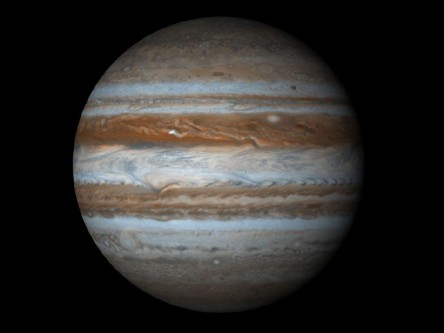
But why is Jupiter’s atmosphere divided up into stripes? Well, the Jovian atmosphere is quite complex and the formation of the stripes is due to several things but perhaps the biggest factor is Jupiter’s spin rate. Whereas a day on Earth lasts 24 hours, on Jupiter your day would only last 9.93 hours. This fast rotation has created Jupiter’s distinctive pattern of stripes running parallel with its equator. When you combine this fast spin rate with the fact that Jupiter is made of gas you get something else interesting: Jupiter isn’t a perfect sphere, it’s very bulgy in the midsection.
Jupiter’s variegated atmosphere is also affected by strong storms with wind speeds close to 400 mph. These storms are fed and shaped by heat energy welling up from within the planet’s interior and by Jupiter’s spin rate. These storms manifest themselves as gargantuan oval-shaped structures, the most famous of which is Jupiter’s Great Red Spot.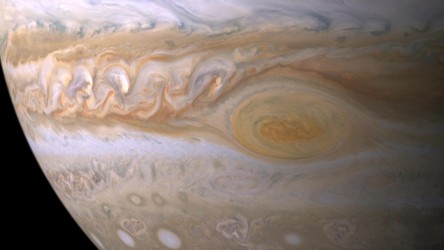 More than twice the size of our own planet Earth, the Great Red Spot is like a hurricane on steroids with wind speeds of some 270 mph. The storm is also persistent and has been spinning in a counterclockwise fashion in the Jovian atmosphere for at least 350 years, perhaps even longer. For reasons unknown, the Great Red Spot has been shrinking in size and becoming fainter in recent years. A moderate sized telescope will reveal it but you will need to know when to look. You can find various web sites and astronomy magazines that will list the transit times for you.
More than twice the size of our own planet Earth, the Great Red Spot is like a hurricane on steroids with wind speeds of some 270 mph. The storm is also persistent and has been spinning in a counterclockwise fashion in the Jovian atmosphere for at least 350 years, perhaps even longer. For reasons unknown, the Great Red Spot has been shrinking in size and becoming fainter in recent years. A moderate sized telescope will reveal it but you will need to know when to look. You can find various web sites and astronomy magazines that will list the transit times for you.
As you dive deeper into Jupiter’s atmosphere something freaky begins to happen to the gas that comprises the planet: due to Jupiter’s incredible mass the pressures become more and more extreme with depth and the gases become a fluid. This liquid hydrogen is what makes up most of Jupiter’s incredible bulk. If you had a craft capable of withstanding the immense pressure (and you can’t so don’t even try!) you would experience this gradual transition from gas to liquid first hand. After descending 30 miles below the clouds you would come upon a 13,000-mile-thick layer of hydrogen and helium.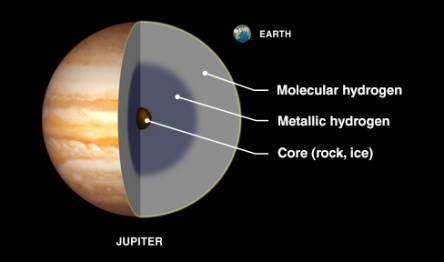 This would slowly change from a gas layer to a liquid layer as you went deeper and deeper into the planet’s interior. After a long journey through this strange liquid you would then encounter something even stranger, a 25,000-mile-deep-sea of liquid metallic hydrogen. The pressure is so immense at these depths that the electrons literally get squeezed out of the hydrogen atoms and, while still having a viscosity like that of water, the liquid becomes a conductor of both heat and electricity, just like a metal. This vast, churning sea of liquid metallic hydrogen then becomes a ginormous generator, creating a magnetic field that extends for some 450 million miles away from the planet. This magnetic field can generate an incredible 10 million amps of electricity.
This would slowly change from a gas layer to a liquid layer as you went deeper and deeper into the planet’s interior. After a long journey through this strange liquid you would then encounter something even stranger, a 25,000-mile-deep-sea of liquid metallic hydrogen. The pressure is so immense at these depths that the electrons literally get squeezed out of the hydrogen atoms and, while still having a viscosity like that of water, the liquid becomes a conductor of both heat and electricity, just like a metal. This vast, churning sea of liquid metallic hydrogen then becomes a ginormous generator, creating a magnetic field that extends for some 450 million miles away from the planet. This magnetic field can generate an incredible 10 million amps of electricity.
In 1979 NASA’s Voyager 1 space probe made an astonishing discovery as it swung by Jupiter before heading on out into to the solar system and beyond: Jupiter has rings. These faint and barely visible rings are made from dust thought to be created by the collisions of small moons that orbit Jupiter.
Speaking of moons, Jupiter has more than any other planet in our solar system with a total of 64 known satellites. The four largest are (moving in order outwards from the planet) Io, Europa, Ganymede, and Callisto. It was once thought that these smaller worlds would be frozen, dead, and uninteresting places but, once again, the Voyager 1 probe turned up some rather interesting discoveries. 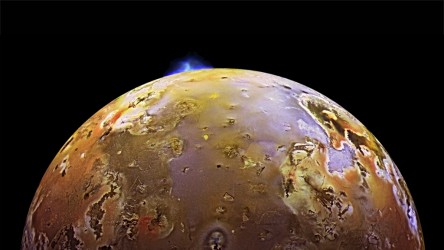 Io, the innermost moon, rather than being a frozen ball of rock turned out to be the most volcanically active spot in our entire solar system. The electrically charged particles the moon’s many volcanoes spit out into space get caught up in Jupiter’s magnetic fields and then funneled back down into the planet’s polar regions. This triggers some of the solar system’s most spectacular aurora displays.
Io, the innermost moon, rather than being a frozen ball of rock turned out to be the most volcanically active spot in our entire solar system. The electrically charged particles the moon’s many volcanoes spit out into space get caught up in Jupiter’s magnetic fields and then funneled back down into the planet’s polar regions. This triggers some of the solar system’s most spectacular aurora displays.
Europa, rather than having an icy surface pockmarked with craters from ancient impacts turned out to have a relatively new, smooth surface. It’s generally accepted now that, due to tidal friction with the planet, Europa has a hot interior that has created a subsurface ocean of liquid water beneath its icy exterior. And who knows, there may even be life dwelling within the ocean’s depths!
You can see these four Galilean moons (named for Galileo who first discovered them in 1610) for yourself with nothing more than binoculars. They will appear as tiny, star-like points orbiting around the planet. There is even an app to show you which ones are visible and their configuration around Jupiter.
So, make sure you get outside this month and spend a little getting to know this amazing alien world.